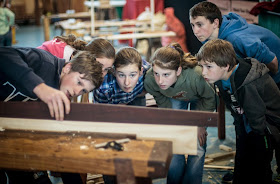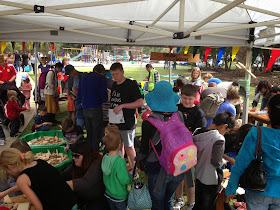My cousin works for a Local Government Authority in the western suburbs of Perth, Western Australia. For risk management reasons, this tree was required to be removed from a well established public garden. Peter contacted me and asked if I was interested. He sent me a picture of the tree, and I said I would like the bottom section of the tree, where the pith would more likely be in the centre of the log.
 |
| The large lower branches meant the best timber would be below this in the lower trunk. |
I was unable to be there on the day the Arborists removed the tree, but I turned up the following day with the aim of splitting the log section down into quarters with my wedges in order to make the log more manageable for me to remove it from the site.
 |
| The log section awaiting me, and my box of wedges next to it. the rest of the huge tree had been chipped and totally removed from the site. |
London Plane, Plantanus x acerifolia, is understood to be a hybrid between the Oriental Plane (Plantanus orientalis) and the American Sycamore (Plantanus occidentalis). It was first recorded in Spain in the 17th Century. London Plane trees are commonly grown in cities around the world, with lots of these deciduous shade trees being planted around Perth for many years now. I have never had the chance to play with this timber before.
After Peter first phoned me, I did some research on the Net, hoping to know more about the tree and it's timber. I read with interest a cabinetmaker in the UK saying what beautiful timber it was with its lacey grain structure. The lacey grain figure is caused by prominent medullary rays. Would this mean that the timber wound cleave (split) easily? I had hoped so. Hence I arrived on site with my box of wedges with the idea of breaking the log down so I would take it away in manageable chunks.
 |
| A pencil line marks the chosen line for the first split. |
After careful assessment of the log, I chose what I thought would be the best line through the log for the first split. This line must pass through the pith (the centre of the tree). Wedges would be driven into the end of the log all along this line to start the process.
 |
| With a line of wedges being driven into the end of the log, the split starts to spread down the side. |
As the split starts to extend down the side of the log, bark is removed along the forming crack and wedges inserted and driven in to help the split to extend further along the log. While you hope the split will continue along the line of the fibres, there are other forces and factors at work which may see split jump across the line of fibres. This took place down one side of the log.
 |
| Splitting the log is easy in theory... but this log put up a huge fight! |
Despite my hopes about the prominent medullary rays making this timber relatively easy to split, the reality was different. It had a very interlocking grain. The log fought all the way. Even with wedges down both sides of the log, assorted timber levers and more, the log just refused to come apart into the required two sections for a very long time. Through dogged persistence, physical grunt, and the effort of two and sometimes even three of us, it finally gave up the fight. We now had two sections.
 |
| At last... the log was split into two very untidy sections. |
With the log now open, we could see why it didn't want to follow the intended line down one side. There was a narrow section of rot inside the log which had hyjacked the cleaving process. Despite this path of least resistence, it had still fought to the end, as evidenced by the tangle of fibres on the face of the right hand section! Contemplation of a few more hours fighting the log further as each of these two halves were split into halves again brought about a practical idea. Use the electric chainsaw to break down the next two sections! These two halves were far too heavy to be able to lift, so the chainsaw was going to be the way forward. I had other work to attend to!
Two of the resulting quarters were left in their long states. The other two were first cut in half along their length. These were cut into smaller chunks ideal for bowl carving.
 |
| The cutting of the half quarters was going well for a while, and then the chainsaw was all of a sudden struggling to stay on a straight course, as seen in the left hand cut. |
On finally completing a very rough cut on the left hand cut, a nail was found inside the tree. Further inspection found another nail in the cut second from the left. You can see where the saw started to deviate. I didn't know it, but we had hit the first of the nails there.
 |
| The chainsaw killer - nails hidden deep inside the log! You can see how the chainsaw was affected! |
Nails and other foreign bodies are a potential hazard inside many garden and backyard trees.
 |
| Another of the nails inside the log. |
With the log cut up into manageable sections that I could lift, we loaded the big sections into the ute and away I went. A nice pile of very interesting wood and more challenges ahead...
At home I used the chainsaw to break down the material further, to create a pile of bowl blanks, chair and stool seats, and leg material for chairs and stools. Several times I would sharpen the chainsaw only to hit yet another nail! It was very frustrating - but such are the hazards of working with garden trees.
 |
| Some of the booty derrived from only one half of the log. Nice! |
Only half of the log was broken down in this way. A couple of friends who are bowl carvers would receive some nice material to work with, and I would still have plenty to play with.
The ends of the sawn pieces were sealed with Titebond III (a great way to use up the gluggy stuff left in the bottom of the big containers of this my favourite glue).
 |
| Ends sealed with Titebond III, the glue drying before packing away. |
As well as the nice pile of bowl blanks, stool and chair seats and leg material, I still have two remaining quaters of the original big log. These ends were sealed too, and hopefully will remain happy as they wait for me to get to them. I am thinking chair back legs, etc...
While not riven or cleft in the traditional manner, I have derrived a great resource from this one piece of that big tree which would otherwise have been chipped up into mulch like the rest of it.
I look forward to making an array of interesting stuff from this nice timber over the coming months.
Thanks, Cousin Pete! The real adventure and an interesting journey now begins...




























































